The recent reveal of the current owner of Patek Philippe's Supercomplication as well as last year's Sotheby's auction of Reginald “Pete” Fullerton, Jr.'s timepieces (he was the grandson of Henry Graves, Jr.) has renewed public interest in one of the watch industry's most famous collecting contests. The story of American inventor James Ward Packard and financier Henry Graves, Jr.'s legendary fascination with complicated timepieces and their ensuing “duel” has now been captured by journalist Stacy Perman in a riveting new book entitled “A Grand Complication,” just published by Atria Books/Simon and Shuster.
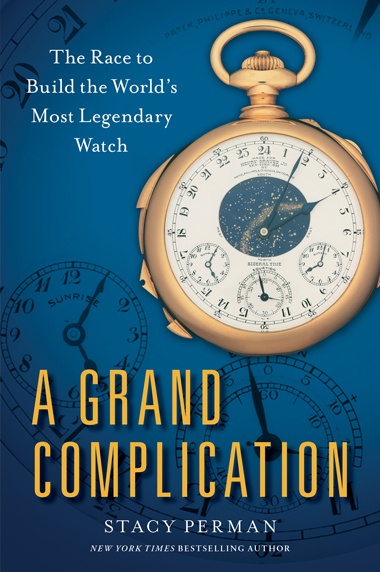
Perman, a freelance journalist, became interested in the topic when “BusinessWeek” sent her to do a story on the Lititz Watch Technicum, a watchmaking school in Pennsylvania founded by Rolex to help make up for the lack of skilled watchmakers in the United States. “It was there I learned about this small story that really told a bigger story,” she said. Perman began researching and writing this book in 2009, which goes beyond the story of two men to graphically describe the growth of America and the burgeoning watch collector scene in the United States in a way that will certainly appeal to far more than the horologically-minded.
The race for the Supercomplication was not only a collector's pursuit, but also one in which quality manufacturers of the time competed to make the most complicated watches: an era that would make, break, and solidify all-important reputations ultimately setting certain companies up for a rosy future, provided they could make the most of their creations in terms of marketing. The reputations built during this time represent foundations for today's “top of the heap” status for brands like Patek Philippe, Vacheron Constantin, and Breguet.
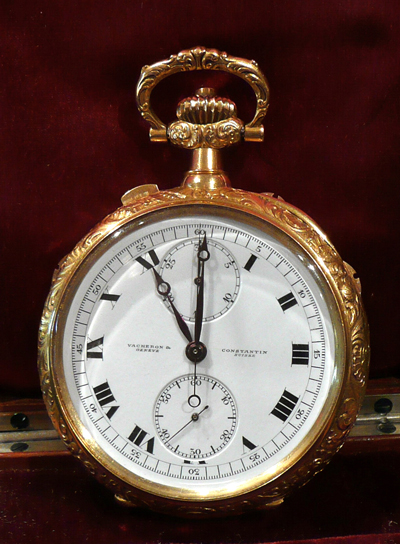
While Perman's extensively researched book hits its climax with the delivery of the watches known as the Packard and the Supercomplication, these are not the only historical timepieces with roles in the story.
Graves actually found his way into horology through his family's interest in art and antiques, and he owned long case clocks by English masters such as Thomas Tompion, George Graham, and Joseph Knibbs. Packard, in fact, began his collecting with masters such as Dent, Victor Kullberg (chronometer maker to king of Sweden), Guex, and Chevalier before moving on to Jules Jürgensen, Agassiz (later to become Longines), Waltham, and of course Vacheron Constantin.
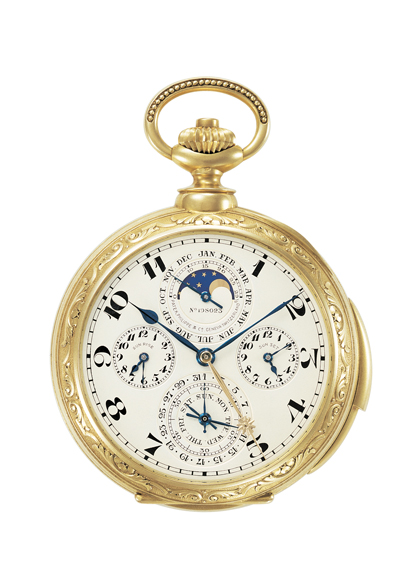
Packard took possession of his first Patek Philippe pocket watch in 1905 and his first Patek Philippe wristwatch in 1918, though Perman writes that he considered the wristwatch more of a novelty. The Patek Philippe pocket watch that has come to be known as The Packard was in 1927 the most complicated watch in the world at that time and “was the masterpiece of his entire collection and the apotheosis of his relationship with Patek Philippe,” Perman writes. Housed in an elaborately engraved 18-karat gold case, it contained ten customized complications including an equation of time display calibrated to Warren, Ohio (where Packard lived) shown by a gold hand ending in a sun (today a common sign denoting the hand for the equation of time). A blue enamel moon phase display is nestled inside a subdial at 12 o'clock that also shows the month. Across the dial at 6 o'clock, a subdial containing three small hands provides information on the weekday, date, and leap year. Naturally, the calendar functions are all perpetual. The subdial at 9 o'clock shows the time of sunrise, while that at 3 o'clock displays the time of sunset; both are specifically calibrated to the latitude and longitude of Warren, Ohio. The slide on the side of the case allowed the carillon (three-gong) minute repeater to ring on demand. Popping open the back by pressing on the crown allowed Packard to view a blue enamel celestial chart of 500 stars reproducing Warren, Ohio's night sky. Part of its romance was that it rotated daily to display the real-time night view outside Packard's mansion.
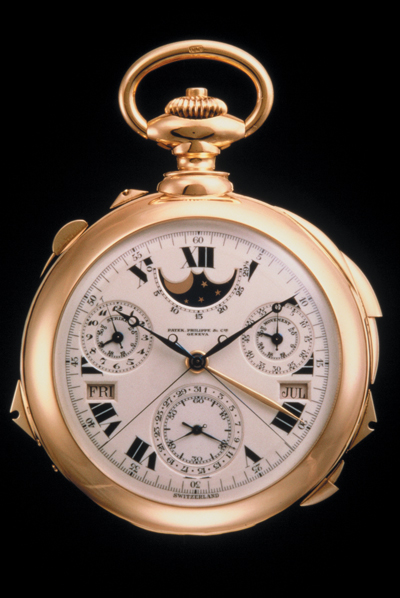
Graves received his Supercomplication on January 19, 1933. Comprising 24 complications, it is the most complicated watch in history, surpassing Breguet's Marie Antoinette, the Leroy No. 1, and the Packard. Less decorative in nature than the Packard, the focus remains on its complicated nature, which includes a celestial chart of the night sky over New York City, a Westminster chime minute repeater, sidereal time, an alarm, a perpetual calendar, a split-second chronograph, and times of sunrise and sunset calibrated to New York City. Comprising 900 components, it took Patek Philippe eight years to manufacture.
The Supercomplication has continued to make headlines throughout its history, most notably in 1999 when Sotheby's sold it for $11,002,500 to an anonymous buyer. Four months ago Bloomberg revealed that Sheik Saud Bin Mohammed Bin Ali Al-Thani of Qatar's royal family had pledged the Supercomplication along with three other watches and some art to Sotheby's to cover outstanding debt of $83 million. This means that Sotheby's may well have the opportunity to sell it once again.
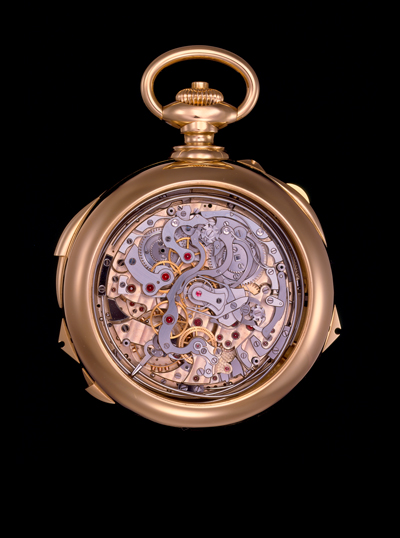
“A Grand Complication” ends with an epilogue on the whereabouts of the Supercomplication and discusses a few lingering mysteries, which you will have to read about yourself. Visit the Frick Collection museum in New York City on March 28 to hear Perman speak about the book if you are in the U.S. The book may be ordered through
Watchprint.com.









